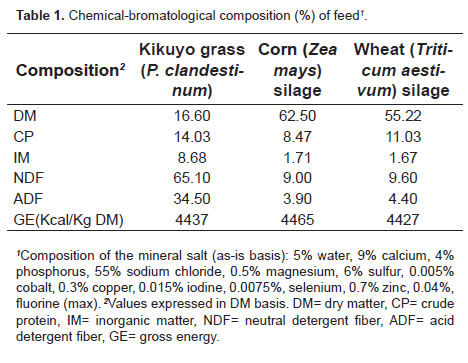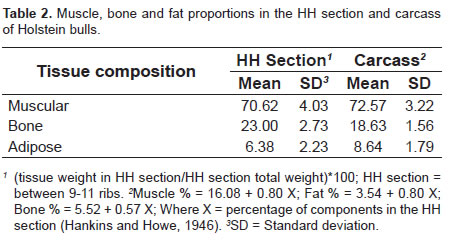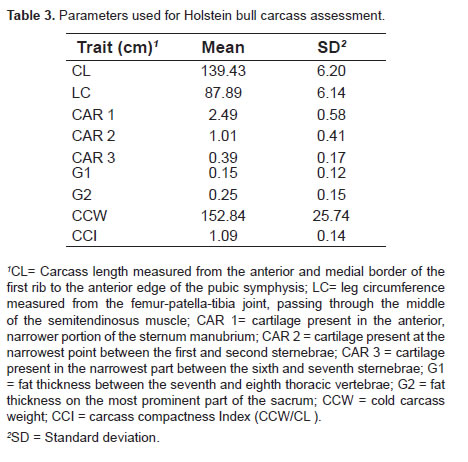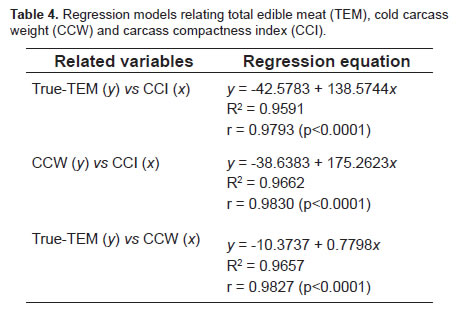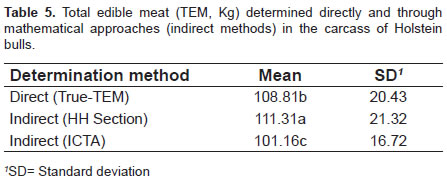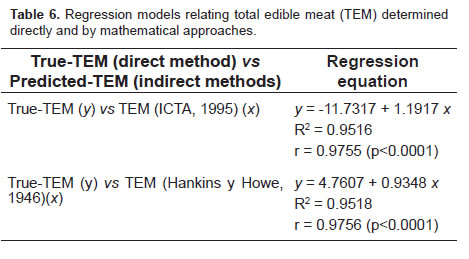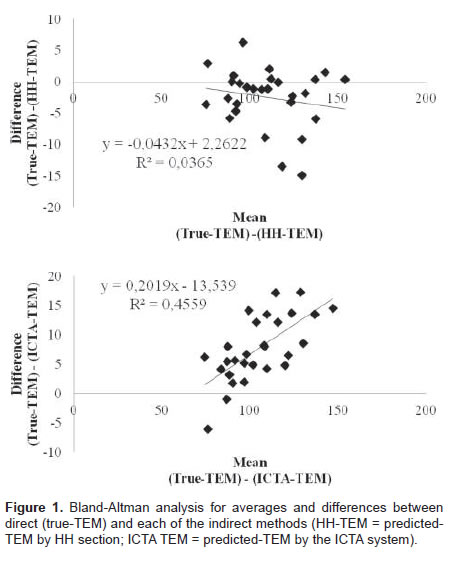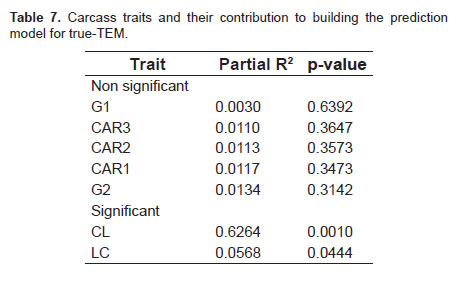Services on Demand
Journal
Article
Indicators
-
 Cited by SciELO
Cited by SciELO -
 Access statistics
Access statistics
Related links
-
 Cited by Google
Cited by Google -
 Similars in
SciELO
Similars in
SciELO -
 Similars in Google
Similars in Google
Share
Revista Colombiana de Ciencias Pecuarias
Print version ISSN 0120-0690
Rev Colom Cienc Pecua vol.26 no.3 Medellín July/Sept. 2013
ORIGINAL ARTICLES
Comparison of methods to determine total edible meat in the male Holstein cattle carcass¤
Comparación de métodos para determinar el total de carne aprovechable en la canal de machos Holstein
Comparação de métodos para determinar o total de carne aproveitável na carcaça de bezerros holandeses
Sandra L Posada1*, Zoot, MSc, PhD; Ricardo Rosero Noguera1, Zoot, MSc, PhD; Raúl Valásquez2, Zoot, MSc; Alvaro Hoyos1, Zoot; Juan Manuel Cerón3, Zoot.
* Corresponding author: Sandra Lucia Posada Ochoa. Grupo de Investigación en Ciencias Agrarias-GRICA, Facultad de Ciencias Agrarias, Universidad de Antioquia. Carrera 75 N º 65-87, AA 1226, Medellin, Colombia. E-mail: slposada@gmail.com
1Grupo de Investigación en Ciencias Agrarias (GRICA), Facultad de Ciencias Agrarias, Universidad de Antioquia, AA 1226, Medellín, Colombia.
2 Departamento de Producción Animal, Facultad de Ciencias Agropecuarias, Universidad Nacional de Colombia, Medellín, Colombia.
3 Cooperativa Lechera de Antioquia (COLANTA), Medellín, Colombia.
(Received: February 13, 2012; accepted: November 16, 2012)
Summary
Background: the objective of beef cattle farming is to produce young animals with adequate proportions of meat, fat and bone. In many countries, including Colombia, research on carcass quality and performance has focused on Bos indicus, resulting in little information available on Bos taurus breeds, particularly Holstein. Objective: to compare several methods for determining total edible meat (TEM) in the carcass of intact Holstein males slaughtered at 330 kg and 26 months of age. Methods: the TEM was determined by the direct method (true-TEM), and also by two indirect methods based on equations. One equation involving carcass measurements was proposed by the Instituto de Ciencia y Tecnología de Alimentos (ICTA). The other equation is based on the muscle proportion between ribs 9-11. Results: variance analysis detected statistically significant difference (p<0.05) among all methods. The relationship between true-TEM and that estimated by indirect methods was high (r =0.9756). However, according to Bland-Altman interchangeability analysis, the direct method is not interchangeable with the prediction by ICTA. The TEM variability obtained by the three methods was similar (average CV = 18.15%). Conclusion: according to this study, the method based on the muscle proportion between ribs 9-11 is useful for estimating TEM in Holstein bull carcasses.
Keywords: animal slaughter, bio-modeling, Bos taurus, carcass conformation, growth measurements.
Resumen
Antecedentes: el objetivo de la ganaderia de carne es producir animales jóvenes para sacrificio, con proporciones adecuadas de carne, hueso y grasa. En países como Colombia, las investigaciones sobre calidad y rendimiento en canal se han concentrado en ganado Bos indicus, existiendo muy poca información sobre razas Bos taurus, particularmente Holstein. Objetivo: comparar varios métodos para determinar el total de carne aprovechable (TEM) en la canal de machos Holstein enteros, sacrificados a un peso aproximado de 330 Kg y 26 meses de edad. Métodos: la determinación del TEM se realizó mediante el método directo (TEM real) y dos métodos indirectos basados en el empleo de ecuaciones, a saber, la ecuación propuesta por el Instituto de Ciencia y Tecnología de Alimentos (ICTA) utilizando mediciones realizadas en la canal, y la basada en la proporción de músculo presente en la sección comprendida entre las costillas 9 y 11. Resultados: el análisis de varianza permitió detectar diferencia estadística significativa (p<0,05) entre todos los métodos evaluados. La relación entre el TEM real y el estimado desde los métodos indirectos fue alta (r =0,9756). Sin embargo, el análisis de intercambiabilidad de Bland-Altman permitió concluir que el método directo no es intercambiable con la predicción realizada a partir del sistema ICTA. La variabilidad del TEM obtenido por los tres métodos fue similar (CV medio =18,15%). Conclusión: de acuerdo con este estudio, el método basado en la proporción de músculo entre las costillas 9 y 11 es útil para estimar el TEM en la canal de machos Holstein.
Palabras clave: biomodelación, Bos taurus, conformación de canales, crecimiento sacrificio animal.
Resumo
Antecedentes: o objetivo do sector pecuário é produzir animais jovens, que assegurem proporções adequadas de carne, osso e gordura no momento do abate. Na Colômbia, as pesquisas sobre qualidade e rendimento da carcaça têm-se centrado em gado Bos indicus, e pouca informação existe na raça Holstein. Objetivo: comparar vários métodos de determinação do total de carne aproveitável (TEM) na carcaça de bezerros não castrados Holstein, abatidos, aproximadamente, aos 330 Kg de peso e 26 meses de idade. Métodos: o TEM foi determinado através do método directo (TEM real) e de dois métodos indirectos baseados no uso de equações, a saber, a equação proposta pelo Instituto de Ciencia y Tecnología de Alimentos (ICTA) usando mensurações feitas na carcaça, e a equação baseada na proporção de músculo presente na secção entre a 9ª y 11ª costela. Resultados: a análise de variância permitiu detectar diferença estatisticamente significante (p<0,05) entre todos os métodos avaliados. A relação entre o TEM real e o predito desde os métodos indirectos foi elevada (r = 0,9756). No entanto, a análise de Bland-Altman permitiu concluir que o método directo não pode se substituir pela predição feita a partir do sistema ICTA. A variabilidade do TEM obtido desde os três métodos foi similar (média CV =18.15%). Conclusão: de acordo com este estudo, o método baseado na proporção de músculo entre a 9ª y 11ª costela é útil para estimar TEM na carcaça de machos Holstein.
Palavras chave: abate animal, Bos taurus, biomodelação, conformação de carcaça, crescimento.
Introduction
The beef cattle industry seeks to produce highperforming animals to be slaughtered at a young age, ensuring carcasses have adequate proportions of meat, bone and fat. Total edible meat (TEM) is the most relevant of those fractions (Brito and Sampaio, 2001), as its protein is what gives the product its nutritional value (Diaz-Chiron, 2001). Quantifying TEM allows paying producers on a differentiated base and also to infer to what extent the livestock sector is adequately addressing its market requirements.
Carcass composition is influenced by age, breed, weight, sex, and nutritional status of the animal (Veras et al., 2001). Proportions of carcass tissues can be calculated by direct or indirect methods. Direct methods are very accurate but laborious, involving dissection, separation, and weighing of tissues (Veras et al., 2001). Conversely, indirect methods use equations to predict composition based on the carcass or its parts (Veras et al., 2001; Brito and Sampaio, 2001). Indirect methods include the use of specific gravity (Alhassan et al., 1975; Hedrick, 1983), the composition of the section between ribs 9-11 (Hankins and Howe, 1946), and ultrasonography (Berg et al., 1997). Upon applying equations described in other studies, some researchers have detected discrepancies between actual and predicted values (Kempster, 1981) because the equations must be used under the same circumstances of breed, age at slaughter, husbandry, and animal handling conditions. Indirect methods used in this study sought to predict TEM from evaluations routinely conducted during carcass processing without having weighed all meat cuts. In general, studies on carcass quality and yield have focused on Bos indicus cattle (Fernandez and Jaramillo, 1997; Correa, 1998; Vasquez et al., 2005). There is little information for non-beef cattle breeds, such as the Holstein, whose males are slaughtered at a young age. The aim of this study was to compare different methods for determining TEM in the carcass of Holstein bulls raised for meat production.
Materials and methods
Location
The animals were fattened at Los Dolores farm, located in Abejorral municipality (Antioquia, Colombia), in an area corresponding to lower montane rain forest (bh-MB; Holdridge, 2000). Slaughtering was carried out in Frigocolanta, a commercial slaughterhouse owned by Cooperativa Lechera de Antioquia (Colanta), located in Santa Rosa de Osos municipality (Antioquia, Colombia). The distance and transport time from the farm to the slaughterhouse was 183 km and 12 hours, respectively.
Animals and management
A total of 28 intact Holstein males were used. The animals were fed on a rotational grazing system with Kikuyu grass (Pennisetum clandestinum) and supplemented daily with 1 kg of reconstituted grain silage (corn and wheat). Mineral salt and water were offered ad libitum throughout the production cycle. The chemical composition of the feed is presented in table 1.
Animals were slaughtered at 26 months of age, weighing approximately 330 kg. Prior to transport to the slaughterhouse, the animals were fasted for 6 hours, and then weighed to determine body weight on the farm (BWF). Once in the slaughterhouse, animals were weighed again to record the weight at the arrival (BWS) and to calculate weight losses during transport. Then, animals were housed in groups of 14 bulls (3.5 m2/animal) and spent another 12 hours without feed but with free access to drinking water.
Animal slaughter was conducted according to the procedures regularly followed by the slaughterhouse, using a captive bolt stunner to numb and immediately kill the animals. Hot carcass weight (HCW) was measured approximately 15 minutes post mortem. Then, carcasses were kept at 6 °C for 24 hours and weighed to obtain cold carcass weight (CCW). Carcass yield was calculated based on the CCW and the BWS. The following measurements were taken in the cooler in accordance with the procedures stated by the ICTA system for carcass classification (Amador et al., 1995): carcass length (CL), leg circumference (LC), backfat thickness (G1 and G2), and cartilage quantification (CAR1, CAR2 and CAR3). The carcass compactness index (CCI) was calculated using CL and CCW, according to the methodology proposed by Bianchi et al. (2006), where CCI = CCW/CL (kg/cm).
Before deboning, a sample from the left carcass was collected and weighed. The sample was taken between ribs 9-11 (HH section). Then, dissection and prediction of carcass proportions of muscle, fat and bone was conducted, using the equations proposed by Hankins and Howe (1946):
Muscle proportion: Y = 8.16 + 0.80 X
Adipose tissue proportion: Y = 3.54 + 0.80 X
Bone proportion: Y = 5.52 + 0.57 X
Where X = percentage of components in the HH section.
During deboning, cuts were weighed using a scale (accuracy: 0.2 kg).
Determination of total edible meat (TEM)
The TEM was determined by a direct method and two indirect methods. For the direct method, cuts obtained during carcass deboning were weighed to obtain the true-TEM. On the other hand, the indirect methods were based on equations, namely, the system proposed by the ICTA (Amador et al., 1995), in which: TEM (kg) = [- 40.82 + (0.567 * CCW) - (1,770 * G1) - (2,781 * G2) + (0.248 * CL) + (0.247 * LC)], and also on the equation described by Hankins and Howe (1946), which is based on the proportion of muscle in the HH section.
Statistical Analysis
Several statistical procedures were performed to analyze the TEM value obtained by the direct (true-TEM) and indirect methods. A completely randomized design was used to evaluate the treatment effect (represented by the estimation methods) on TEM, using CCW as a covariate and the Tukey test for comparison of means. Spearman correlation analysis and linear regression were used to evaluate the degree of relationship between methods. Finally, the Bland-Altman analysis was used to assess interchangeability between methods (Bland and Altman, 1986).
Spearman correlation analysis and multiple regression (Backware method) were conducted for true-TEM and the following variables: CL, LC, G1, G2, CAR1, and CAR3 CAR2. Simple regression and Spearman correlation analysis were also conducted between true-TEM, CCI and CCW. These analyses were complemented by descriptive statistics (mean and standard deviation). All statistical procedures were done with the SAS statistical program (2001), with a 5% significance level.
Results
Muscle, fat and bone tissue means (%) obtained in the carcass and HH section are presented in table 2. The coefficients of variation (CV) for the respective tissues were 5.71%, 11.86%, and 35.03% in section HH, and 4.44%, 8.36%, and 20.68% in the carcass.
Means and standard deviation of the parameters proposed by ICTA (Amador et al., 1995) are presented in table 3. The CL and LC traits showed very low dispersion around the mean (CV < 10%), while ossification-related measures showed greater variability (CV: 35.90%), although lower than that of fat cover at G1 and G2, whose CV were 80.21% and 63.01% respectively. The CCW and CCI values, shown in the same table, had a CV of 16.85% and 13.22%, respectively.
Table 4 presents the regression models used to predict true-TEM and CCW from CCI, and the equation to estimate true-TEM from CCW. The intercept and regression slope were statistically significant (p<0.05) in all cases, and the coefficient of determination (R2) exceeded 95%. The Spearman's correlation coefficient (r) between these variables was high, greater than 95%, and highly significant (p<0.0001).
Table 5 shows the true-TEM obtained by dissection and separation of all body parts, the estimated using the ICTA system (Amador et al., 1995), and the estimate from HH section (Hankins and Howe, 1946).
Analysis of variance found statistically significant difference (p<0.05) between the direct and each of the indirect methods, as well as among the latter. Regarding variability around the mean value, the three methods showed a similar pattern: the CV ranged between 16.53% and 19.16% for the TEM estimation with ICTA system and HH section, respectively, while the true-TEM had an intermediate value.
The degree of relationship between the true- TEM (y) and each of the indirect methods (x) was high, and the Spearman correlation coefficients (r) were virtually identical (r = 0.9755 and 0.9756) (Table 6). The linear regression equations relating these variables are shown in the same table, where regression slopes were highly significant (p<0.0001).
Figure 1 shows the level of agreement between the direct (true-TEM) and each of the indirect methods, assessed with the Bland-Altman interchangeability test. The Spearman correlation coefficient (r = 0.6752) and the regression slope (β = 0.2019) were statistically significant (p<0.0001) when assessed in the regression and correlation analysis for differences (y) and means (x) between true and predicted-TEM by the ICTA. When the same analyses were performed between true and predicted-TEM using the HH section, neither the correlation coefficient (r = -0.1912) nor the regression slope (β = -0.0432) were statistically significant (p>0.05), indicating that both methods are interchangeable for estimating TEM.
The multiple regression equation obtained by the true-TEM (y) and the carcass classification traits proposed by the ICTA (x) corresponded to: y = -248.52 + (1.88 * CL) + (1.08 * LC), where the intercept (β0) and the coefficients (β1 and β2) were statistically significant (Table 7). The R2 maximum for the resulting regression equation was 0.6832, with CL and LC being the only statistically significant variables (p<0.05).
Spearman correlations between true-TEM-CL (r= 0.7915) and true-TEM-LC (r = 0.7120) were significant (p<0.0001). The relationship between true-TEM and each of the evaluation points for cover fat (G1 and G2) was also significant (p<0.05), although smaller in magnitude (r = 0.3997 and 0.5450, respectively). The Spearman correlation coefficient was not significant (p>0.05) between true-TEM and CAR, CAR3, and CAR2 (data not shown in table).
Discussion
Carcass yield
Noguera et al. (2012) evaluated the effect of animal transport on live weight and carcass yield. They reported 8.40 ± 1.10% of BWF as the weight loss after an eight-hour trip to the slaughterhouse, slightly higher than the range suggested by Siemens (1996) for Holstein steers (between 5.5% and 7% of body weight). Carcass yield was 50.60 ± 1.60%, which is consistent with the percentages reported by Gorrachategui (1997) for dairy cattle performance (50% to 53%). Jorge et al. (2009) reported 47.0%, 47.3% and 48.2% carcass yield for Holstein steers slaughtered at 450 kg, 510 kg and 600 kg, respectively, slightly lower values than those obtained in the present work. In general, experimental results show greater carcass yield for beef-type breeds compared to dairy breeds or mestizos (Peron et al., 1993a; Leme et al., 2000; Fernandes et al., 2004). Considering dietary factors, Danner et al. (1980) noted the inverse linear relationship between the size of organs and carcass yield. Grazing animals whose diet is primarily forage —as in this study— have high abdominal capacity, large organs and low meat yield.
Carcass composition
According to Carvalho et al. (2003), tissue accumulation in animals follow certain patterns of priority; first the viscera grows, then the bone and muscle tissue, and finally the adipose tissue. Carvalho et al. (2003) evaluated tissue composition of Holstein calves slaughtered at 87 kg. They found 55.98%, 31.92%, and 7.2% muscle, bone, and adipose tissue, respectively, determined in the HH-section. In Holstein calves slaughtered at 170 kg, Almeida Júnior et al. (2008) found 61.57%, 19.97%, and 17.76% for muscle, bone, and fat, respectively. Signoretti et al. (1999) evaluated Holstein calves slaughtered at 190 kg, obtaining similar means: 59.60% for muscle, 18.51% for bone and 21.80% for fat. Rodrigues Filho et al. (2003) evaluated Holstein males slaughtered at 215 kg, reporting 64.78% muscle, 17.28% bone, and 18.15% fat. Finally, Zea et al. (2008) in 370 kg, 410 kg, and 450 kg Holstein bulls found percentages of muscle, bone, and fat, fluctuating between 72.31% to 72.93%, 22.22% to 22.49%, and 4.57% to 5.47%, respectively, which closely resembles those observed in the present study, specifically the muscle and fat components (Table 2). According to the trend presented in the cited studies, muscle tissue increases with body weight at slaughter. Animals slaughtered at an older age are more likely to deposit muscle tissue, following the growth sequence described by Scanes (2003): first nerve, then bone, followed by muscle and adipose tissue.
The similarity between bone tissue predicted from HH section in this study and the percentage referenced in the literature (Junior Almeida et al., 2008; Zea et al., 2008; Rodrigues Filho et al., 2003; Signoretti et al., 1999) could be due to the fact that bone proportion in the carcass has the lowest percentage change and slowly decreases as total weight increases. The bone proportion observed by the cited researchers and the present study were relatively similar, although the slaughter weights varied greatly (between 170 kg and 450 kg). This is because bone tissue grows faster at an early age, muscle tissue at an intermediate age, and adipose tissue at an older age (Berg and Butterfield, 1979).
Finally, this study showed a low fat percentage compared to the previously cited reports. This could be a result of differences in nutritional management, since the animals were kept in pasture and wet grain silage represented only 1 kg/day. The high CV for this component (CV = 35.03%) is supported by Prescott (1982), who argues that fat is the carcass component with the highest quantitative variability, even in animals of the same weight. Genotype and sexual condition of animals in this study may also have determined the predicted fat percentage from HH section. Bos taurus breeds and intact animals have less fat deposition in the carcass. At a similar gain rate, larger breeds at maturity —that is, more delayed for adipose tissue deposition— have a higher percentage of protein in relation to fat, reflecting increased muscle tissue and reduced adipose tissue (Toelle et al., 1986). Furthermore, taurine breeds have more abundant internal fat deposits versus peripheral fat in comparison to Zebu (Peron et al., 1993b). Regarding sexual condition, intact males have less body fat than castrated males. The low fat deposition and increased protein gain in intact animals is explained by the secretion of androgenic hormones, which are steroid substances with pronounced anabolic effects (Guiroy et al., 2002).
Carcass evaluation according to the ICTA system
The study of carcass traits is important for the farmer and the meat packing industry. It allows the farmer to monitor the final product's quality and allows the packer to evaluate the purchased product. The carcass has edible and inedible meat, with bones representing the majority of the inedible portion. As the animal grows, the amount of cartilage decreases to form bone, leading to a decrease in the CAR values (1, 2 and 3). Cartilage quantification at the anatomical sites described by ICTA allowed determining animal age (2 to 3 years), although with a high variability (Table 3). Nevertheless, this variability was not a constraint to establish the ossification age because of the range the system assigns to each parameter (CAR 1 = 1.0 to 3.0; CAR 2 = 0.5 to 1.0; CAR 3 = 0.3 to 0.6, for animals between 2 and 3 years of age). However, variability for CAR 2 led to a value outside the proposed reference limits.
According to the total fat coverage and intermuscular fat determined at G1 and G2 sites, carcasses in this study had a low degree of finish (grade 0; Table 3). Variability in this parameter may lead to bias in carcass classification, considering that standard deviation for G1 and G2 would allow assigning a grade 1 scoring. Fat coverage, besides being an indication of carcass composition in terms of fat percentage (Nunes de Souza, 2010) is associated with quality, as it protects meat against redness by dehydration and cooling. According to Pereira et al. (2008) and Jorge et al. (2009), fat coverage should be between 3 mm and 6 mm. According to this, the average value observed in this study ensured low water loss during cooling and low carcass weight loss.
Contrary to the parameters used to assess cartilage tissue and degree of finish, dispersion around the mean was very low for LC and CL (Table 3). The LC measures carcass conformation degree, thus assessing muscle development. According to the ICTA system, high conformation implies the animal is better suited for meat production, larger cuts and higher proportion of meat per carcass are obtained, and higher carcass quality and commercial value can be expected. The average LC value found in the present study (87.89 cm) implies an excellent carcass conformation degree (greater than 80 cm) according to the ICTA rating scale.
The CCI (which is the relationship between CCW and CL) is more interesting than CL alone. The higher the CCI the greater the amount of muscle tissue and therefore the greater the carcass yield (Urrutia et al., 2010). The regression and correlation analysis (Table 4) confirmed the positive and significant relationship between CCW-CCI and true-TEM-CCI, in agreement with Urrutia et al., 2010. According to Soria et al. (2011) CCI is related to muscularity, allowing comparing carcasses regardless of their weight. The mean value for this variable (1.09 kg/cm; Table 3) is below the values reported by Urrutia et al. (2010) (between 2.19 and 2.33), and Carballo et al. (2004). Working with cattle, the latter authors indicated that CCI was between 1.81 and 1.95 for the highest conformation carcasses, while the lowest conformation fluctuated between 1.38 and 1.57 kg/cm. The low values in this study are possibly due to the early age at which animals were slaughtered and their genetic group, as both traits may affect the degree of muscle tissue deposition.
Determination of total edible meat
The analysis of variance detected statistically significant difference between all TEM methods (Table 5). The regression analysis and Spearman correlation (Table 6) shows a strong relationship between the direct and indirect methods. These results, however, should be taken with discretion, considering regression-correlation analysis assesses the relationship degree, but not matching (interchangeability) between methods. The Bland- Altman test (Figure 1) is based on correlation and regression analysis for differences (y) and means (x) between the methods compared. In this test, the Spearman correlation coefficient (r) and the regression slope (β) were statistically significant when true-TEM was compared with predicted- TEM by the ICTA. Statistical significance of r and β indicates that the discrepancy between direct and indirect methods proposed by the ICTA was not constant throughout the distribution range, but showed a tendency to increase with increasing values. When the direct method (true-TEM) was contrasted with the indirect based on HH section composition, the differences had a tendency to decrease with increasing average values. However, both r and β were not statistically significant, leading to the conclusion that both methods can be interchanged. The trend in the Bland-Altman interchangeability test corresponds with the mean values in the evaluation methods. As shown in table 5, the TEM value estimated by ICTA was 7.03% lower than the true value, while predicted-TEM from HH section was 2.30% higher. While the three methods were statistically different, the lowest difference between the direct and the HH section method is in agreement with the interchangeability registered. In the Bland-Altman test, the differences (residuals) between true-TEM and ICTA TEM were mostly positive, which is why the points are above zero in the abscissa (Figure 1), concluding that the ICTA system underestimates the true values. The opposite situation occurred for residuals between true-TEM and TEM estimated from HH section.
Finally, it is important to highlight the statistical significance of CL and LC independent variables in the multiple regression equation used to predict true-TEM (Table 7). This corresponds with the positive and relatively high correlation presented between these variables (r = 0.7915 for CL true- TEM; r = 0.7120 for LC true-TEM), which did not happen between true-TEM and G1, G2, CAR 1, CAR 2, and CAR 3. Velasquez and Alvarez (2004) also reported a positive correlation between LC and TEM (r = 0.62), though it was smaller than that in the present study.
According to this study, the method based on the muscle proportion between ribs 9-11 is useful for estimating carcass TEM in male Holstein cattle. However, more studies are needed to validate this conclusion. Furthermore, a greater age at slaughter is proposed in order to obtain a better degree of finish and more edible meat, considering that Holstein (Bos taurus) arrives to maturity later than Zebu (Toelle et al., 1986).
Notas
¤ To cite this article: Posada SL, Rosero R, Val ásquez R, Hoyos A, Cerón JM. Comparison of methods to determine total edible meat in the male Holstein cattle carcass. Rev Colomb Cienc Pecu 2013; 26:159-168.
Acknowledgements
The authors wish to thank Cooperativa Lechera COLANTA (Colombia) for the use of their slaughter facilities, and Carlos Velásquez, Santiago Berrio and FRIGOCOLANTA staff for their collaboration. Appreciation is also expressed to Proyecto de Sostenibilidad 2011-2012 (CODI, Universidad de Antioquia, Colombia) and Ministerio de Agricultura y Desarrollo Rural for providing funds to conduct this study.
References
Alhasssan WS, Buchanan-Smith JG, Usborne WR, Ashton GC, Smith GC. Predicting empty body composition of cattle from carcass weight and rib cut composition. Can J Anim Sci 1975; 55:369-376. [ Links ]
Almeida Júnior GA, Costa C, De Carvalho SMR, Persichetti Júnior P, Panichi A. Composição físico-química de carcaças de bezerros holandeses alimentados após o desaleitamento com silagem de grãos úmidos ou grãos secos de milho ou sorgo. Rev Bras Zootec 2008; 37:164-170. [ Links ]
Amador I, Palacios A, Maldonado M. Sistema ICTA de clasificación de canales y cortes de carne bovina. Cartilla guía. Ministerio de Agricultura y Desarrollo Rural, ICTA-UN, SENA, IICA, FEDEFONDOS (Eds.). Colombia; 1995. [ Links ]
Berg RT, Butterfield RM. Nuevos conceptos sobre desarrollo de ganado vacuno. Zaragoza: Acribia; 1979. [ Links ]
Berg EP, Neary MK, Forrest JC, Thomas DL, Kauffman RG. Evaluation of electronic technology to assess lamb carcass composition. J Anim Sci 1997; 75:2433-2444. [ Links ]
Bianchi G, Garibotto G, Feed O, Bentancur O, Franco J. Efecto del peso al sacrificio sobre la calidad de la canal y de la carne de corderos Corriedale puros y cruza. Arch Med Vet 2006; 38:161- 165. [ Links ]
Bland JM, Altman DG. Statistical methods for assessing agreement between two methods of clinical measurement. The Lancet 1986; 1:307-310. [ Links ]
Brito RM, Sampaio AAM. Efeito de fontes de proteína nas características da carcaça e avaliação do rendimento de carne aproveitável estimada por meio de equações de regressão linear múltipla em touros ¾ Canchim ¼ Nelore. ARS Veterinaria 2001; 17:64-70. [ Links ]
Carballo JA, Oliete B, Moreno T, Sánchez L, Monserrat L. Categorización de las canales de ternero producidas en Galicia. Arch Zootec 2004; 53:119-128. [ Links ]
Carvalho PA, Sánchez LMB, Velho JP, Viégas J, Jauris GC, Rodrigues MB. Características quantitativas, composição física tecidual eregional da carcaça de bezerros machos de origem leiteira aonascimento, 50 e 110 dias de idade. Rev Bras Zootec 2003; 32:1476-1483. [ Links ]
Correa D. Influencia del sexo y la condición sexual, en el rendimiento en canal y en carne de bovinos. Trabajo de grado (Zootecnia), Facultad de Ciencias Agropecuarias, Universidad Nacional de Colombia (Medellín); 1998. [ Links ]
Danner ML, Fox DG, Black JR. Effect of feeding system on performance and carcass grade of yearling steers, steers calves and heifer calves. J Anim Sci 1980; 50:394-404. [ Links ]
Díaz-Chirón MT. Características de la canal y de la carne de corderos lechales manchegos. Correlaciones y ecuaciones de predicción. Tesis de Doctorado, Facultad de Veterinaria, Universidad Complutense de Madrid (España); 2001. [ Links ]
Fernandes HJ, Paulino MF, Martins RGR, Valadares Filho SC, Torres RA, Paiva LM, Da Silva AT. Composição corporal de garrotes inteiros de três grupos genéticos nas fases de recria e terminação. Rev Bras Zootec 2004; 33:1581-1590. [ Links ]
Fernández A, Jaramillo L. El beneficio integral de la carne y su incremento en la rentabilidad. En: Memorias del Seminario ''Carne y Leche'', Competitividad en su Producción. Medellín, 1997. pp. 35-39. [ Links ]
Gorrachategui M. Influencia de la nutrición y otros factores en el rendimiento de la canal en terneros. XIII Curso de Especialización FEDNA. Ibérica de Nutrición Animal SL 1997; [access date: february 6, 2012] URL: http://www1.etsia.upm.es/fedna/capitulos/97CAP_VI.pdf [ Links ]
Guiroy PJ, Tedeschi LO, Fox DG, Hutcheson JP. The effects of implant strategy on finished body weight of beef cattle. J Anim Sci 2002; 80:1791-1800. [ Links ]
Hankins OG, Howe PE. Estimation of the composition of beef carcasses and cuts. Washington, D.C. (Tech. Bulletin - USDA, 926); 1946. [ Links ]
Hedrick HB. Methods of estimating live animal and carcass composition. J Anim Sci 1983; 57:1316-1327. [ Links ]
Holdridge LR. Ecología basada en zonas de vida. 5th ed. San José de Costa Rica: Instituto Interamericano de Cooperación para la Agricultura, IICA.; 2000. [ Links ]
Jorge JRV, Zeoula LM, Prado IN, Silva RR, Andrade RV, Macedo LMA, Prado JM, Bublitz EE, Marques JA. Gordura protegida sobre o desempenho, carcaça e composição química da carne de novilhos holandés. Arch Zootec 2009; 58:371-382. [ Links ]
Kempster AJ. The indirect evaluation of sheep carcass composition in breeding schemes, population studies and experiments. Liv Prod Sci 1981; 8:263-271 [ Links ]
Leme PR, Boin C, Margarido RCC, Tedeschi LO, O'farril JC, Alleoni GF, Albino LF. Desempenho em confinamento e características de carcaça de bovinos machos de diferentes cruzamentos abatidos em três faixas de peso. Rev Bras Zootec 2000; 29 Suppl 2:2347-2353. [ Links ]
Noguera RR, Velásquez R, Hoyos A, Posada SL, Pérez E. Efecto del transporte sobre el peso vivo, rendimiento en canal y algunos aspectos de calidad de carne en machos Holstein. Livest Res Rural Dev 2012; 24, Article #81 [access date: september 19 2012] URL: http://www.lrrd.org/lrrd24/5/nogu24081.htm [ Links ]
Nunes de Souza DD. Avaliação das características de tourinhos F1 Guzerá-Nelore e F2 Pardo Suiço-Guzerá-Nelore terminados em confinamento. Dissertação de Mestrado, Programa de pósgraduação em Zootêcnia, Universidade Federal Rural do Rio de Janeiro (Brasil); 2010. [ Links ]
Pereira A, Brondani IL, Restle J, Glasenapp LF, Oliveira L, Lopes da Silveira SR. Características quantitativas da carcaça de novilhos jovens e superjovens com peso de abate similares. Ciênc Anim Bras 2008; 9:300-308. [ Links ]
Peron AJ, Fontes CAA, Lana RP, Paulino MF, Queiroz AC, Freitas JA. Rendimento de carcaça e de seus cortes básicos e área corporal de bovinos de cinco grupos genéticos, submetidos a alimentação restrita e ad libitum. Rev Soc Bras Zoot 1993a; 22:238-247 [ Links ]
Peron AJ, Fontes CAA, Lana RP, Silva DJ, Queiroz AC, Paulino M. Tamanho de órgãos internos e distribuição da gordura corporal em novilhos de cinco grupos genéticos, submetidos a alimentação restrita e ad libitum. Rev Soc Bras Zoot 1993b; 22:813-819. [ Links ]
Prescott JHD. Crecimiento y desarrollo en los corderos. En: British Council, editor. Manejo y enfermedades de las ovejas. 1st ed. Zaragoza: Acribia; 1982. p.351-369 [ Links ]
Rodrigues Filho M, Mancio AB, Lana RP, Cecon PR, Silva FF, Barreto NE, Veloso CM. Desempenho e características de carcaça de novilhos de origem leiteira, alimentados com diferentes níveis de concentrado e de cama de frango. Rev Bras Zootec 2003; 32:672-682. [ Links ]
SAS/STAT: Guide for Personal Computer [programa de ordenador]. Versión 8.2. Cary (NC): SAS Institute Incorporation; 2001. [ Links ]
Scanes CG. Biology of growth of domestic animals. USA: Iowa State Press; 2003. [ Links ]
Siemens MG. Manging Holstein steers for beef production. Cooperative Extension Publications 1996; [access date: february 6, 2012] URL: http://learningstore.uwex.edu/assets/pdfs/A3659.pdf [ Links ]
Signotetti RD, Silva JFC, Valadares Filho SC, Pereira JC, Araújo GGL, Cecon PR, Queiroz AC, Muniz EB. Crescimento, conversão alimentar e rendimento de carcaça de bezerros da raça holandesa alimentados com dietas contendo diferentes níveis de volumoso. Rev Bras Zootec 1999; 28:185-194. [ Links ]
Soria ETV, Peña JAP, Lozano MSR, Medina DM. Comportamiento productivo y características de la canal en corderos provenientes de la cruza de ovejas Katahdin con machos de cuatro razas cárnicas especializadas. Rev Mex Cienc Pecu 2011; 2:247-258. [ Links ]
Toelle VD, Tess MW, Johnson T, Andersen BB. Lean and fat growth patterns of serially slaughtered beef bulls fed different energy levels. J Anim Sci 1986; 63:1347-1360. [ Links ]
Urrutia GRT, Escalante AS, Palma MGV, Pellat RP, Guzmán DAP. Caracterización de canales y de carne de bovino de animales engordados en la zona centro de Sonora. Rev Mex Cienc Pecu 2010; 1:157-168. [ Links ]
Vásquez R, Pulido JI, Abuabara Y, Martínez R, Abadía B, Arreaza LC, Silva J, Sánchez LE, Ballesteros HH, Muñoz C, Rivero T, Nivia A, Barrera G. Patrones tecnológicos y calidad de la carne bovina en el caribe colombiano. Corpoica, Colciencias, Fedegán 2005; [access date: february 6, de 2012] URL: http://200.75.42.3/SitioWeb/Archivos/Publicaciones/Patronestecnolgicosycalidad.pdf [ Links ]
Velásquez JC, Álvarez LA. Relación de medidas bovinométricas y de composición corporal in vivo con el peso de la canal en novillos Brahman en el valle del Sinú. Acta Agron 2004; 53:61-68. [ Links ]
Véras ASC, Valadares Filho SC, Coelho da Silva JF, Paulino MF, Cecon PR, Valadares RFD, Ferreira MA, Silva CM, Silva BC. Predição da Composição Química Corporal de Bovinos Nelore e F1 Simental x Nelore a partir da Composição Química da Seção Hankins e Howe (Seção HH). Rev Bras Zootec 2001; 30 Supl:1112-1119. [ Links ]
Zea J, Díaz MD, Carballo JA. Efecto del peso de sacrificio y la raza en la canal de terneros alimentados con ensilados. Arch Zootec 2008; 57:295-306. [ Links ]













